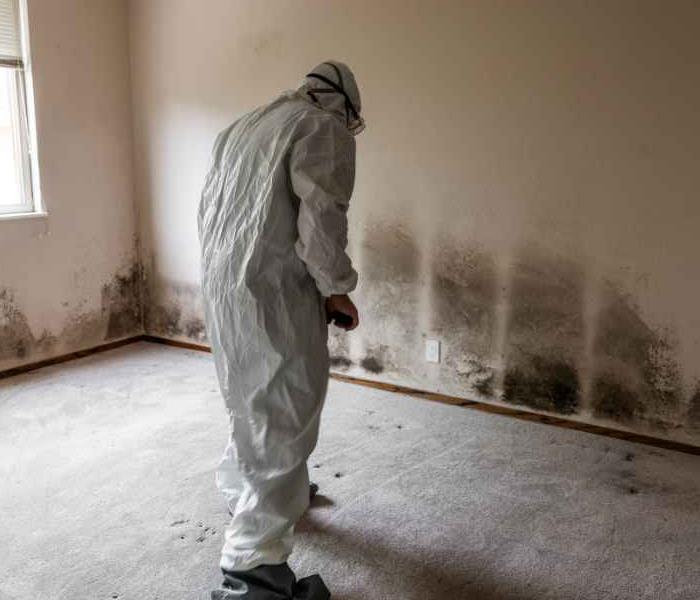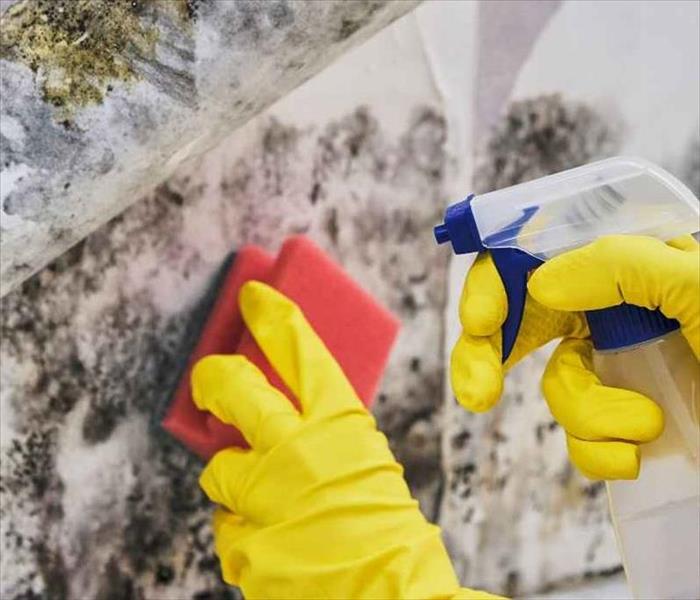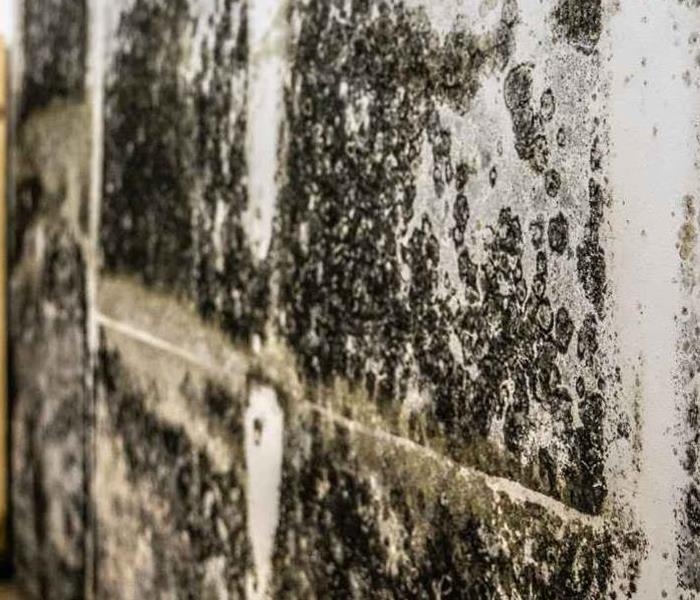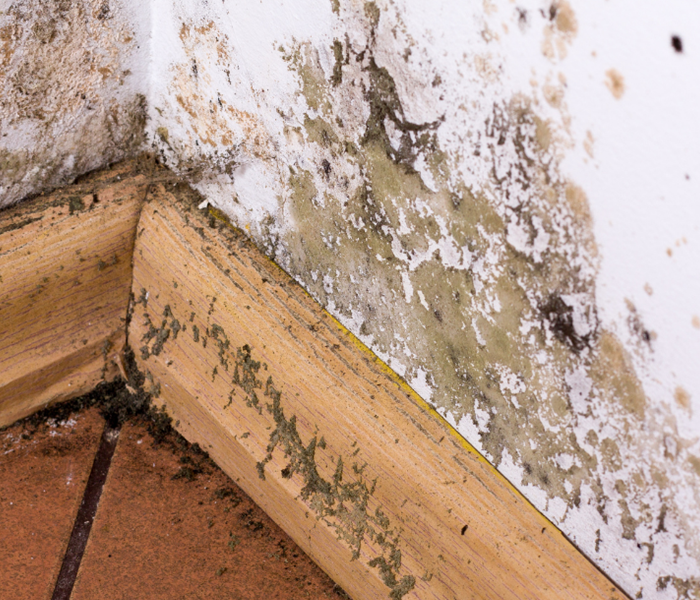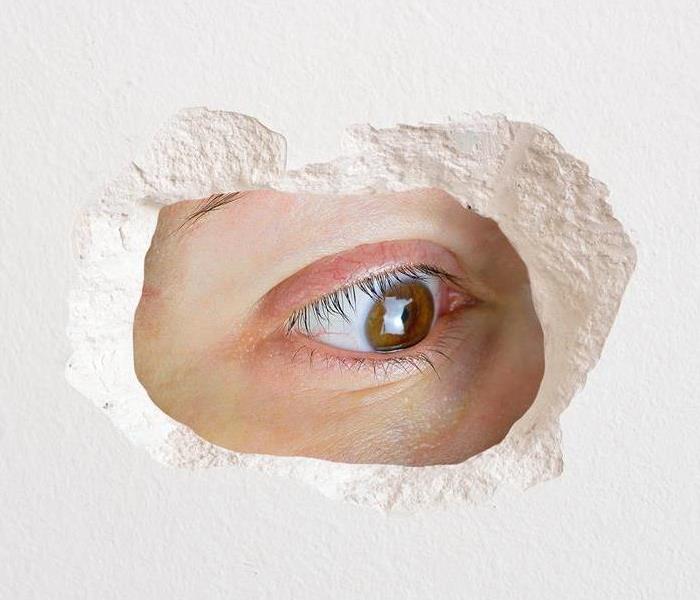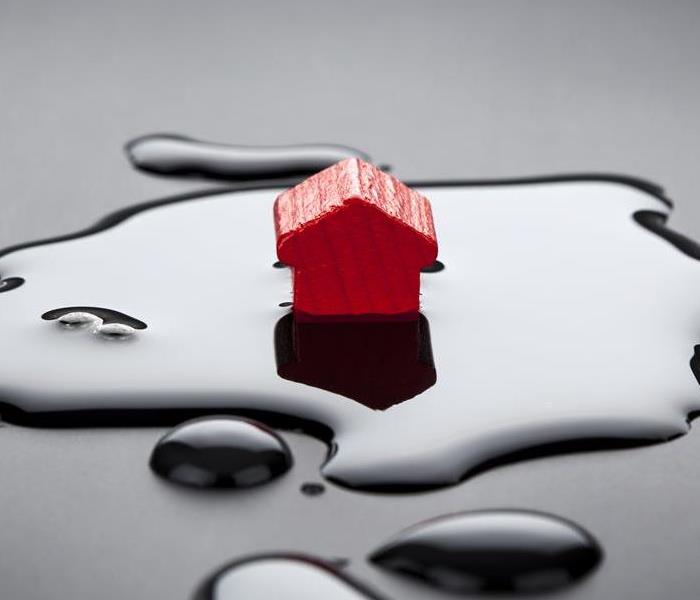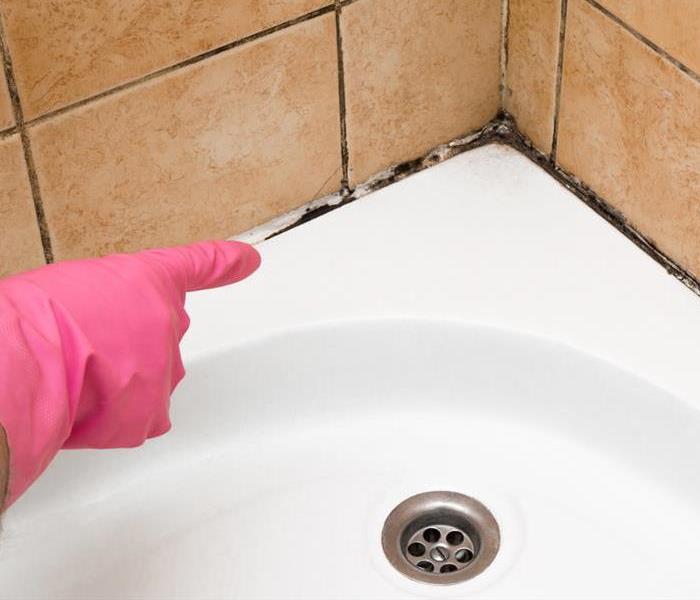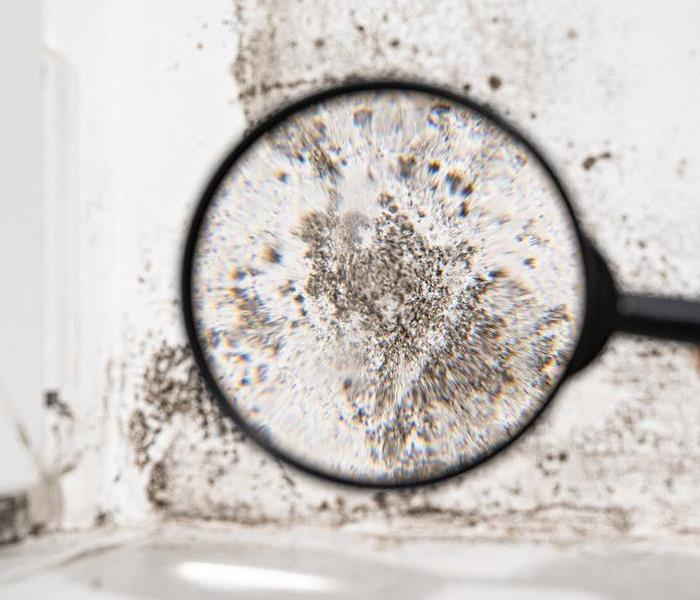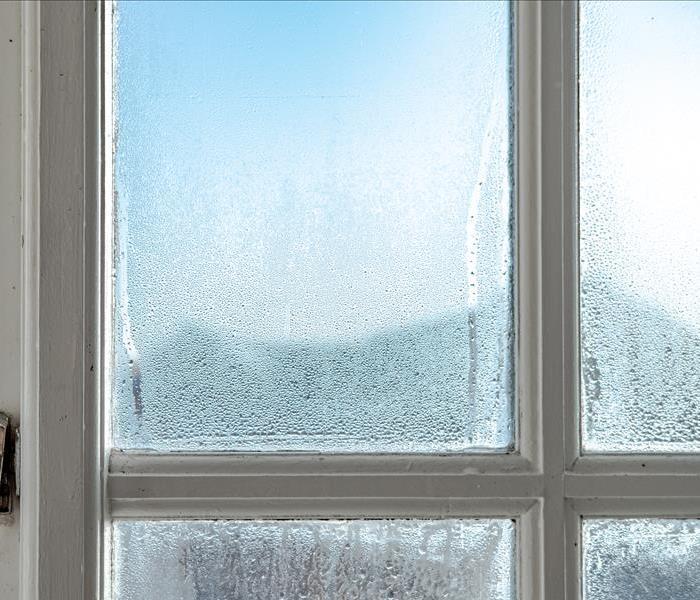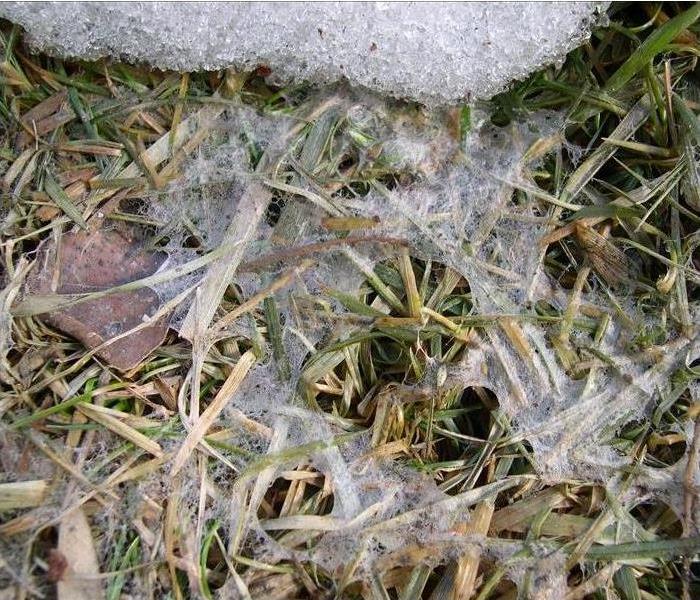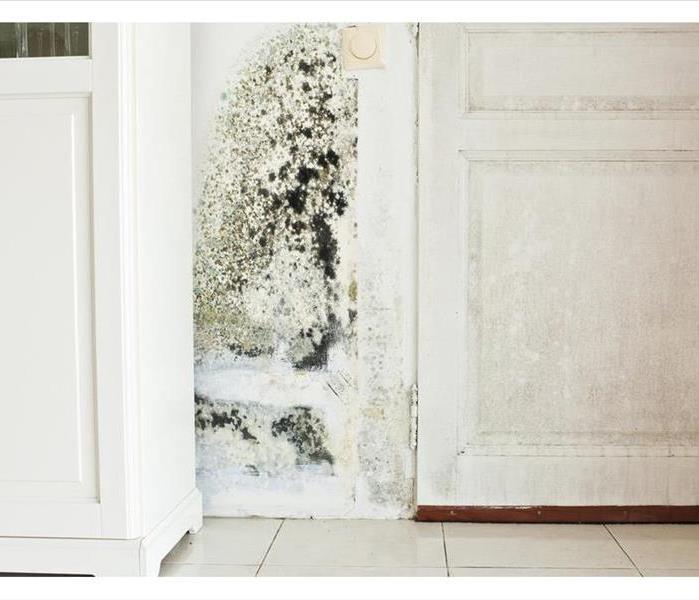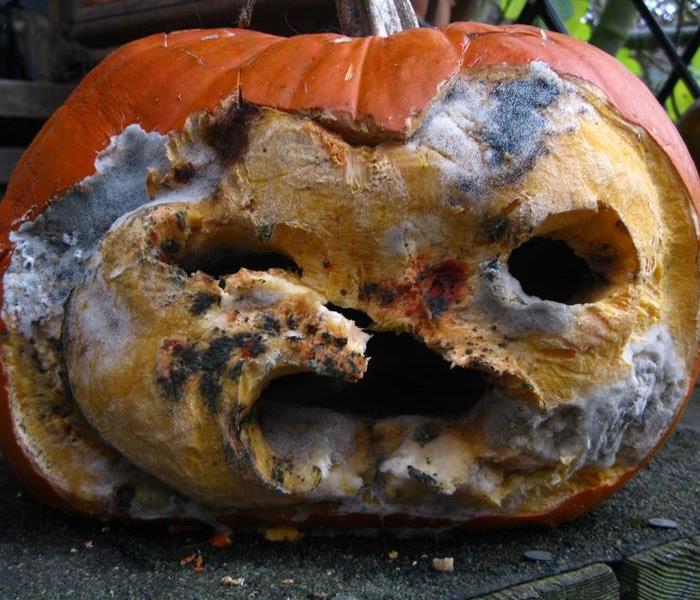Recent Mold Remediation Posts
The Mold Remediation Process: What to Expect
3/13/2025 (Permalink)
Mold is more than an eyesore—it can pose serious risks to your health and property if left untreated. When mold issues arise, understanding the remediation process is key to ensuring your home or business in East Meadow and Westbury is safe and mold-free. At SERVPRO of East Meadow and Westbury, we specialize in professional mold remediation. Here’s what you can expect from our comprehensive process.
Step 1: Inspection and Assessment
The first step in mold remediation is identifying the extent of the problem. Our experts:
- Conduct a thorough inspection to locate visible mold and hidden growth areas.
- Use specialized equipment, such as moisture meters and infrared cameras, to identify sources of moisture contributing to mold growth.
- Develop a detailed plan tailored to your property’s specific needs.
This initial step ensures that we address the root cause of the problem, not just the symptoms.
Step 2: Containment
To prevent mold spores from spreading during remediation, we establish containment measures, including:
- Setting up physical barriers with plastic sheeting.
- Using negative air chambers to isolate the affected area.
- Turning off HVAC systems to avoid spreading mold through the air ducts.
These precautions protect your property and the health of everyone on-site.
Step 3: Air Filtration
Mold spores can linger in the air, even after visible growth is removed. We use advanced air filtration systems, including HEPA filters, to capture airborne spores and improve air quality. Air scrubbers and negative air machines are employed to ensure the containment area remains clean during the remediation process.
Step 4: Mold Removal
Mold removal involves eliminating both visible growth and mold-infested materials that cannot be salvaged. This step includes:
- Cleaning mold from surfaces like walls, ceilings, and floors using specialized antifungal and antimicrobial treatments.
- Safely disposing of contaminated materials, such as drywall, insulation, and carpeting, that cannot be restored.
- Using tools like wire brushes, dry ice blasting, or sanding for stubborn mold colonies.
At SERVPRO of East Meadow and Westbury, we prioritize thorough and safe mold removal to restore your property effectively.
Step 5: Cleaning and Disinfection
Once the mold is removed, we focus on cleaning and disinfecting the affected areas. This includes:
- Cleaning furniture, clothing, and personal belongings.
- Applying antimicrobial treatments to prevent future mold growth.
- Deodorizing the area to eliminate any lingering musty odors.
Our team ensures every surface is thoroughly treated to leave your home or business feeling fresh and clean.
Step 6: Restoration
The final step in the mold remediation process is restoring your property to its pre-mold condition. Depending on the extent of the damage, restoration may involve minor repairs or significant reconstruction. This could include:
- Replacing drywall or insulation.
- Painting and refinishing walls.
- Installing new carpeting or flooring.
SERVPRO of East Meadow and Westbury is equipped to handle all aspects of restoration, ensuring a seamless transition from remediation to repair.
Why Choose SERVPRO of East Meadow and Westbury for Mold Remediation?
Mold remediation is a complex process that requires professional expertise. At SERVPRO of East Meadow and Westbury, we:
- Follow industry-leading practices to ensure effective and safe mold removal.
- Use advanced equipment and technology for thorough remediation.
- Provide fast, reliable service to minimize disruption to your home or business.
Take Action Against Mold Today
If you’re dealing with mold in East Meadow or Westbury, don’t wait—address the issue quickly to protect your health and property.
Contact SERVPRO of East Meadow and Westbury for expert mold remediation services. Our team is here to help you every step of the way, from inspection to restoration. Call us today to schedule your consultation!
Preventing Mold After Water Damage: Essential Tips and Strategies
10/17/2024 (Permalink)
Water damage in your home or business can be a daunting ordeal, and if not properly managed, it can lead to an even more serious issue: mold growth. Mold thrives in moist environments, making post-water damage scenarios a prime breeding ground. For the residents and businesses in East Meadow or Westbury, taking proactive steps to prevent mold after water damage is crucial. SERVPRO of East Meadow/Westbury is here to provide you with essential tips and strategies to mitigate mold risks, ensuring your property remains safe, healthy, and mold-free.
Keep Your Home Clean
Act Quickly to Dry Out
The first 24 to 48 hours after water damage are critical in preventing mold growth. Mold spores can begin to grow and spread within this timeframe, so acting swiftly to remove water and dry out your property is paramount.
Professional Drying Techniques
While you can start the drying process with fans and dehumidifiers, professional water damage restoration services like SERVPRO of East Meadow/Westbury have the advanced equipment needed to expedite the drying process, ensuring all areas, even those not visible, are thoroughly dried.
Identify and Repair Sources of Moisture
Identify and repair the source of any water intrusion. Whether it’s a leaky roof, broken pipe, or faulty window seal, addressing these issues promptly can prevent further water damage and mold growth.
Insulation and Ventilation
Ensure your property is well insulated and ventilated, particularly in areas prone to moisture, such as bathrooms, kitchens, and basements. Good airflow helps keep these areas dry and reduces the risk of mold.
Clean and Disinfect
After drying out your property, cleaning and disinfecting all affected surfaces is a vital step in preventing mold. Mold spores can cling to surfaces and, if not properly cleaned, can begin to grow when conditions become favorable again.
Professional Mold Prevention Treatments
SERVPRO of East Meadow/Westbury offers specialized cleaning services that include antimicrobial and antifungal treatments to further protect against mold growth after water damage.
Stay Vigilant
Regularly inspect your property for signs of water damage or mold, especially after heavy rains or plumbing issues. Early detection can prevent widespread mold growth and the need for extensive mold remediation.
Humidity Control
Maintain indoor humidity levels between 30% and 50%. Use dehumidifiers if necessary, especially during hot, humid months, to keep moisture levels in check.
Why Choose SERVPRO of East Meadow/Westbury for Mold Remediation?
Choosing SERVPRO of East Meadow/Westbury means opting for a team that not only excels in water damage restoration but also specializes in mold remediation. Our certified professionals are trained to handle mold safely and effectively, using the latest techniques and equipment to ensure your property is restored to a safe and healthy environment.
Concerned About Mold After Water Damage?
Preventing mold growth after water damage requires quick action, proper drying and cleaning, and ongoing vigilance. By following these essential tips and strategies, you can significantly reduce the risk of mold in your property. And remember, if you suspect mold growth or need assistance with water damage restoration, SERVPRO of East Meadow/Westbury is here to help. Our expertise in mold remediation ensures that your property is not just cleaned, but restored to a condition "Like it never even happened."
Don't wait for mold to become a bigger problem. Contact SERVPRO of East Meadow/Westbury for expert mold remediation services. Our team is ready to assess your situation, provide a comprehensive solution, and restore your peace of mind. Reach out today and protect your property from the risks of mold.
Identifying Common Mold Hotspots in Your East Meadow and Westbury Home
2/5/2024 (Permalink)
Find Mold Before It Grows
East Meadow and Westbury are communities known for their charm and beauty. As proud homeowners in these areas, it's crucial to be aware of potential mold hotspots that can affect the integrity of our homes and the health of our families. In this blog, we'll explore some common areas where mold tends to thrive and how to identify the early signs of mold growth.
Shower and Bath Areas
Bathrooms, with their high humidity levels, are prime breeding grounds for mold. Check the grout between tiles, shower curtains, and any hidden corners for signs of mold growth. Regular cleaning and proper ventilation can help combat this common issue.
Damp and Dark Spaces
Basements and crawl spaces often provide the perfect conditions for mold to flourish. Inspect these areas for any signs of water leaks, dampness, or musty odors. Adequate ventilation and moisture control are key to preventing mold growth in these secluded spaces.
Under the Sink and Around Appliances
Kitchens are not immune to mold, especially in areas prone to water exposure. Regularly inspect beneath sinks, around dishwashers, and near refrigerators with water dispensers. Quick repairs and vigilant cleaning routines can help keep mold at bay.
Insulation and Ventilation
Attics, often neglected, can harbor mold due to inadequate insulation and ventilation. Check for water stains on the ceiling, proper insulation, and any signs of leaks. Ensuring proper airflow and insulation can go a long way in preventing mold growth.
Be Proactive with Inspections
Implement routine home inspections to catch mold early. Keep an eye on areas with a history of water damage, such as around windows, doors, and the roof. Swift action can prevent small issues from turning into major mold infestations.
By staying vigilant and proactive, you can identify and address potential mold hotspots in your East Meadow and Westbury home before they become larger problems. If you suspect mold growth, don't hesitate to contact SERVPRO® of East Meadow/Westbury for professional mold remediation services.
Act Now with SERVPRO of East Meadow/Westbury
Don't let mold compromise the safety of your home. Contact SERVPRO of East Meadow/Westbury for expert mold remediation services. Our skilled team is ready to assess, remediate, and restore your home to a mold-free and healthy environment. Call us today and let us help you breathe easier in your beautiful East Meadow and Westbury residence.
Preventing Mold Growth in Your Home in East Meadow and Westbury
12/4/2023 (Permalink)
Breathe Easy
When it comes to maintaining a healthy and happy home, one of the last things you want to deal with is mold growth. Mold not only looks unsightly but can also pose serious health risks. Thankfully, there are several steps you can take to prevent mold growth and ensure a safe, mold-free environment for your family in East Meadow and Westbury.
Keep It Dry
Mold loves moisture, so one of the most effective ways to prevent it is by keeping your home dry. Regularly inspect your home for leaks, whether from the roof, plumbing, or windows, and address them promptly. Use a dehumidifier in damp areas like basements and bathrooms to reduce humidity levels, which can inhibit mold growth.
Ventilation Is Key
Proper ventilation can make a world of difference in preventing mold. Make sure your kitchen and bathroom have exhaust fans to remove moisture, and ensure your home is well-ventilated, allowing air to circulate freely. Open windows and doors when the weather allows, which can help reduce indoor humidity.
Monitor Indoor Humidity
Invest in a hygrometer to measure indoor humidity levels. The ideal range is between 30-50%. If your home consistently falls outside of this range, consider using a dehumidifier to maintain healthy moisture levels.
Proper Insulation
In colder climates like East Meadow and Westbury, inadequate insulation can lead to condensation, which can fuel mold growth. Proper insulation in your home can help maintain a consistent temperature and reduce the risk of condensation.
Regular Cleaning
Regular cleaning and maintenance can go a long way in preventing mold. Keep an eye on areas that tend to accumulate moisture, such as the bathroom and kitchen, and clean them thoroughly. Ensure that you also clean and maintain your HVAC system, as mold can thrive in dirty air ducts.
Watch for Warning Signs
Stay vigilant for early signs of mold growth. These can include a musty odor, discolored patches on walls or ceilings, or even allergy symptoms in family members. The sooner you detect a problem, the easier it is to address.
Call in the Experts
If you suspect or discover mold in your home, it's crucial to take immediate action. Mold can be harmful to your health, and trying to remove it yourself can be risky. That's where SERVPRO® of East Meadow/Westbury comes in. Our professional mold remediation service is just a phone call away. We have the experience, equipment, and expertise to safely and effectively remove mold from your home, leaving it clean and healthy once more.
Don't wait until mold becomes a major problem. Follow these tips to prevent mold growth and maintain a healthy environment in your East Meadow and Westbury home. If you ever need assistance with mold remediation, SERVPRO of East Meadow/Westbury is here to help. Contact us today to ensure your home remains a mold-free haven for you and your family. Your health and peace of mind are our top priorities.
Fall Allergies and Indoor Air Quality: Tips for East Meadow and Westbury Residents
9/14/2023 (Permalink)
Breathe Easier this Fall: Indoor Air Quality Tips for East Meadow and Westbury
As the leaves change and the air turns crisper in East Meadow and Westbury, it's not just the weather that undergoes a transformation. Fall also brings with it a surge in indoor allergies due to dust, mold spores, and other allergens. Here are some valuable tips to help you maintain better indoor air quality during the season.
Proper Ventilation
Opening windows for a few minutes each day allows fresh air to circulate and helps reduce the concentration of indoor pollutants. Consider using window screens to prevent outdoor allergens from entering.
Air Purification
Investing in a high-quality air purifier with HEPA filters can significantly improve indoor air quality by capturing allergens and airborne particles.
HVAC Maintenance
Regular maintenance of your heating and cooling systems, including cleaning or replacing filters, from your HVAC provider can prevent the circulation of dust and allergens throughout your home.
SERVPRO of East Meadow/Westbury Can Assist
If you're concerned about mold growth, dust accumulation, or indoor allergens, SERVPRO of East Meadow/Westbury's professional team can help. We offer mold remediation, cleaning, and restoration services to ensure your indoor environment is clean and allergen-free.
This fall, take proactive steps to safeguard your indoor air quality. By doing so, you can create a healthier and more comfortable living space for you and your family.
What are the Common Signs of Black Mold?
6/19/2023 (Permalink)
What Should I Know About Black Mold?
Black mold is a type of fungus that can grow indoors and outdoors. It thrives in damp, humid environments and can pose significant health risks if left untreated. This blog will discuss the common signs of black mold and why prompt action is crucial.
If you suspect black mold in your home or business in Nassau County, contact SERVPRO of East Meadow/Westbury for professional mold remediation services.
Identifying Black Mold
1. Visible Mold Growth
The most obvious sign of black mold is the presence of visible patches or streaks of black or dark greenish-black mold on walls, ceilings, or other surfaces. These patches may appear slimy, fuzzy, or powdery in texture.
2. Musty Odor
Black mold releases volatile organic compounds (VOCs) that produce a strong, musty odor. If you notice an earthy, damp, or moldy smell, it could indicate hidden black mold growth.
3. Water Damage or Moisture Issues
Black mold thrives in moist environments, so any areas affected by water damage or excessive humidity are potential hotspots. Keep an eye out for leaks, condensation, or water stains, as these can create a breeding ground for black mold.
4. Allergic Reactions
Black mold spores can trigger allergic reactions in individuals who are sensitive or prone to allergies. Symptoms may include sneezing, coughing, itchy eyes, throat irritation, or respiratory issues. If these symptoms improve when you leave the affected area, it could be due to black mold exposure.
5. Health Effects
Prolonged exposure to black mold can lead to more severe health problems, especially for those with compromised immune systems, respiratory issues, or allergies. Symptoms may range from persistent headaches and fatigue to respiratory infections and skin irritation.
What to Do if You Notice Black Mold
If you notice any signs of black mold in your Nassau County property, it's essential to take immediate action to prevent further damage and safeguard your health. Here's what you should do:
1. Contact SERVPRO of East Meadow/Westbury
For professional mold remediation services in Nassau County, contact SERVPRO of East Meadow/Westbury. Our trained technicians have the expertise and advanced equipment to assess, contain, and safely remove black mold from your property.
2. Avoid Disturbing the Mold
Disturbing black mold can release spores into the air, leading to further contamination. It's crucial to minimize contact with the affected areas and restrict access to prevent the spread of mold.
3. Fix Moisture Issues
Address the underlying moisture problem that allowed black mold to thrive. Repair leaks, improve ventilation, and reduce humidity levels to prevent future mold growth.
Trustworthy Mold Remediation Services in Nassau County, NY
Identifying the common signs of black mold and taking immediate action is crucial for your health and the well-being of your property. If you suspect black mold growth in your Nassau County home or business, don't hesitate to contact SERVPRO of East Meadow/Westbury for professional mold remediation services.
Safeguard your indoor environment and breathe easier with our expert assistance. Call SERVPRO of East Meadow/Westbury today for mold remediation services in Nassau County: (516) 334-2927
How to Spot Mold Behind Drywall
5/4/2023 (Permalink)
How Do You Know If You Have Mold Behind Drywall?
Mold can be a harmful and persistent problem inside your home. It's often difficult to spot and can lurk behind your walls for months or even years before you realize it's there. Identifying mold growth behind drywall is critical for keeping your humble abode safe and healthy.
Signs of Mold Behind Drywall
Here are a few things to look for that could indicate mold growth behind your drywall:
- An unusual smell: A musty odor is often the first sign of unseen mold growth. If you notice a distinct smell that you can't explain.
- Discoloration: Stains, dark spots, or discoloration on your walls or ceilings could suggest that there is moisture trapped behind the drywall, creating a perfect environment for mold to flourish.
- Bubbling or warping: When drywall becomes saturated with moisture, it may bubble or warp. This could indicate that mold is present, as it often feeds on the paper layer of the drywall.
- Health symptoms: Mold exposure can cause various health issues, from mild allergic reactions to more serious respiratory problems. If you or anyone in your home is experiencing unexplained health issues, mold could be the culprit.
The Importance of Professional Mold Removal
If you suspect that there may be mold growth behind your drywall, it's crucial to seek professional help. Attempting to remove the mold yourself could spread spores throughout your home, exacerbating the problem.
Professionals like those at SERVPRO of East Meadow/Westbury have the expertise and equipment needed to safely and effectively remove mold in your home.
What SERVPRO of East Meadow/Westbury Can Offer
At SERVPRO of East Meadow/Westbury, we specialize in mold remediation and removal. Our team of highly trained technicians can assess the extent of mold growth, contain the affected area, and remove the mold safely and efficiently. We also offer air duct cleaning and deodorization services to ensure your home is free of mold spores and any associated odors.
Don't let mold threaten the safety and health of your home. Contact SERVPRO of East Meadow/Westbury to schedule a mold inspection today.
Who In Nassau County Can Help Me With Water Damage?
5/4/2023 (Permalink)
Water Damage Restoration Services in Nassau County, NY
Water damage can be harmful to your home and your health. It can cause structural damage to your property and mold growth that can lead to respiratory problems. Nassau County residents are no strangers to water damage caused by storms and flooding.
This blog post will answer your question, "Who can help me with water damage in Nassau County?" and provide the information you need to protect your home and loved ones.
Causes and Effects of Water Damage in Nassau County Homes
Various sources, including heavy rain, flooding, leaky pipes, and malfunctioning appliances, can cause water damage. If left untreated, it can lead to mold growth, damage to your home's foundation, and more. Some effects of water damage can be:
- Health problems: Water damage can cause mold growth, triggering allergies, respiratory problems, and more.
- Structural damage: When left untreated, water can weaken the structure of your home, causing rot and deterioration of support beams, drywall deterioration, and crump.
- Property damage: Water can cause damage to your carpets, electronics, and furniture.
Why It's Crucial to Act Fast When Dealing with Water Damage
It is crucial to act fast when dealing with water damage. When water damage occurs, it is important to address it as soon as possible to prevent further damage and reduce the risk of mold growth. If left untreated, water damage can cause irreparable harm and result in costly repairs. Acting fast will also reduce the potential health risks associated with mold growth.
The Benefits of Hiring a Professional to Handle Water Damage Restoration
Hiring a professional water damage restoration company can provide numerous benefits to Nassau County homeowners dealing with water damage. Some benefits include:
- Quick response: A professional water damage restoration company will respond promptly to your call.
- Thorough inspection: Professional inspectors have the right equipment and tools to check for hidden water damage thoroughly.
- Mold remediation: Professional water damage restoration technicians know how to deal with mold remediation safely and completely.
- Peace of mind: Hiring a professional water damage restoration team gives you peace of mind knowing your home is in good hands.
Factors to Consider When Choosing a Reputable Water Damage Restoration Company in Nassau County
When searching for a reputable water damage restoration company in Nassau County, consider the following factors:
- Experience and expertise: Choose a company with experience in water damage restoration and a team of experts.
- Licensing, certifications, and insurance: Ensure the company is appropriately licensed, certified, and insured.
- Customer reviews and reputation: Check for online reviews; this can showcase their previous jobs and customers' experiences.
SERVPRO of East Meadow/Westbury is Here to Help
SERVPRO of East Meadow/Westbury's team of water damage restoration professionals has a track record of successful remediation jobs in Nassau County. Our pros are available 24/7 to respond to emergency calls.
Contact us today for help with your water damage restoration needs.
Where Can Mold Hide at Home?
2/21/2023 (Permalink)
Hidden Places Mold Might be Lurking in Your Home
Mold is a fungus that can be found both indoors and outdoors. When it grows indoors, it can cause several health-related issues; that's why it's important to know where to look for mold in your home so you can address any potential problems before they get out of hand.
SERVPRO of East Meadow/Westbury will share five hidden places to look for mold in your home!
Behind Appliances
Your refrigerator and washing machine can be prone to mold growth because they're often located near water sources such as sinks and laundry rooms. Make sure to check behind your appliances for any signs of mold.
Bathroom Tiles
Mold spores are particularly fond of bathrooms due to the moist environment, making bathroom tiles a prime target for mold growth. Check the grout between tiles and inspect the walls around them for discoloration.
HVAC Systems
The air ducts and vents of your heating, ventilation, and air conditioning system can be a source of mold if they're not properly cleaned and maintained. Inspect the system for any signs of dirt or moisture buildup that could cause concern.
Window Sills
Window sills are often overlooked when searching for mold, but they can be a prime spot for growth due to their proximity to outdoor elements. Make sure to check them regularly for discoloration or other signs of mold.
Carpet
Carpet can be prone to mold if it's not properly maintained. Check the underside of your carpet and any furniture or items stored on top of it for signs of moisture or discoloration that could indicate a problem.
Mold Remediation Services in Nassau County, NY
Mold can be dangerous, and it's important to take proper steps to identify and address potential problems as soon as possible. If you’re experiencing mold issues in your home, contact SERVPRO of East Meadow/Westbury for mold remediation services by calling (516) 334-2927.
What is the Difference Between Mold and Mildew?
1/19/2023 (Permalink)
Mold vs. Mildew: What are the Main Differences?
Mold and mildew are two types of fungi that often cause problems in homes. They can grow anywhere there is moisture and have harmful side effects. It can be difficult to tell them apart, but SERVPRO of East Meadow/Westbury is here to help. We will also discuss the differences between mold and mildew, where they grow, and the best practices for cleaning them.
Where Do Mold and Mildew Grow?
Mold is a fungus typically growing in damp and dark places. It often appears as black or green spots in areas with a lot of moisture, such as window sills or pipes. Mold usually has a musty odor and can cause allergic reactions and respiratory problems if left untreated.
Mildew, however, tends to grow in warm and humid environments such as bathrooms and basements. Mildew doesn’t always cause health problems as mold does, but it can damage some materials if left unchecked for too long.
What Do Mold and Mildew Look Like?
The best way to tell the difference between mold and mildew is to look closely at the texture. Mold will be slimy or fuzzy, while mildew will be powdery. Another way to tell them apart is by looking at the color—mold is usually black, green, or blue, while mildew is typically white or gray.
How Should Mold and Mildew be Cleaned?
While mildew can be removed with household cleaning products and a sponge or cloth, mold requires professional remediation. Every mold damage situation is different and requires a unique solution, which is why you should rely on the professionals at SERVPRO of East Meadow/Westbury. Our team offers top-of-the-line mold remediation services to local communities and can help your home recover from mold damage.
Mold Remediation and Restoration in East Meadow/Westbury
SERVPRO of East Meadow/Westbury’s mold remediation specialists are highly trained and use only the industry's most advanced equipment and tools. If you notice mold in your home, call us at (516) 334-2927 or fill out our online contact form to schedule an appointment.
How Do I Prevent Mold in My House?
8/30/2022 (Permalink)
How to Prevent Mold Growth
Mold growth in your home can be a cause of great concern and an invitation to illness, especially if you or any other family members are allergic to mold spores. You don’t have to live with the fear of mold — there are simple steps you can take to prevent mold growth in your living space and keep it from spreading into other areas of your house and your life.
To help you get started, the mold remediation professionals at SERVPRO of East Meadow/Westbury have outlined three easy ways you can prevent mold growth at home below.
Keep the House Clean
Mold loves dark, damp places. So the first step to preventing mold growth at home is to keep your house clean. This means regular vacuuming and dusting, sweeping and mopping floors, and cleaning surfaces like countertops and windowsills.
In the bathroom, be sure to run the exhaust fan during showers and baths, and wipe down wet surfaces afterward. Keep towels dry and stored in a well-ventilated area. In the kitchen, wash dishes soon after meals, clean up spills right away, and ventilate the room when cooking.
Additionally, do laundry frequently, and if possible, line-dry clothing instead of using the dryer. Keep closets clean and dry, and consider using a dehumidifier in particularly humid areas of your home.
Reduce Moisture in Your Home
One of the best ways to prevent mold growth is to reduce moisture in your home. Here are a few simple ways to do that:
- Use a dehumidifier, especially in humid areas like the bathroom or laundry room.
- Fix any leaks right away, whether they’re in the roof, windows, or pipes.
- Ventilate areas where moisture is likely to build up, like the shower and kitchen.
- Dry wet areas immediately, like after mopping the floor or using the shower.
- Store food properly and don’t leave dirty dishes lying around.
Have Open Air Circulation
One of the best ways to prevent mold growth at home is to have open air circulation. This can be accomplished by opening windows and doors regularly, using fans, and avoiding storage in areas that are prone to moisture. By circulating the air, you will reduce the chances of mold spores settling and taking hold.
Need Mold Restoration Services in Nassau County?
If you see or suspect signs of mold in your Nassau County home, SERVPRO of East Meadow/Westbury is here to help. Our Long Island mold remediation and restoration professionals are no strangers to mold and will help quickly restore your property “Like it never even happened.”
Contact us today at (516) 334-2927 or fill out a form for assistance!
Preventing Snow Mold
12/28/2020 (Permalink)
Recently we have witnessed our first snow of the season! This is now an appropriate time to discuss the subject of snow Mold. Snow Mold is caused when there is snow on the ground that is not completely frozen. Snow Mold has also shown to be found under leaves that have not been cleaned up that should have been moved once more before winter set in, or removed altogether.
How is snow Mold prevented?
- Avoid excessive nitrogen fertilizers in the fall
- Mow the lawn until it stops growing
- Clean up leaves in the fall
- Manage thatch to avoid accumulations of more than 2"
Although it can look really gross in the early spring, most snow mold damage will recover in time. Once the area has dried, the infection will end and the grass will grow out and renew itself.
Is Mold An Issue In My House
1/8/2019 (Permalink)
As seasons shift to colder temperatures, we may not worry so much about things like mold and mildew. Even as snow falls and covers the lingering leaves which start to deteriorate on the ground, we may not think twice about the mold that is clearly spreading over it and eating it away. After all, that's outside. Unfortunately, mold can easily invade the home in the winter just as much as it can in any other season. Below, we cover how mold does just that, what you should look out for, and what you can do when you see mold.
How Mold Forms
It's important to understand what mold is and how it spreads. Mold, is essentially a fungus. It spreads itself through spores that settle on surfaces and remain relatively dormant until the right temperature and amount of moisture enter their atmosphere. By that point, the fungus starts to eat and spread even further by deploying more spores. There are species of mold which can be activated in the temperatures typically associated with early winter. You can expect home damage as it spreads should this be something occurring indoors.
What To Look For
While mold comes in varying colors and species, the mold primarily seen in homes is black. It can spread quite quickly as it’s given moisture, which can turn into devastating damage rather quickly. This is why mold is quite common in places that have seen water damage and it’s important to be conscious of environmental changes and ensure effective cleanup. Because mold can eat away at the surface it is attached to, it's important to have it removed quickly by someone who is well-versed in mold restoration.
What You Should Do
When you first notice mold, you can attempt to safely clean it away with bleach or another harsh cleaner, if the amount is small. This helps you limit the amount of home damage caused by the mold and allows for potential containment. Keep an eye on the area you cleaned, if you notice the mold returning, this means you could have a deep rooted below the surface. You should also keep an eye on the areas where water damage has occurred as these are the key areas mold will grow. If this looks like something you’re not totally confident handling, make sure you have it handled by someone who can.
Dealing with the reality of mold damage can be devastating, and we know firsthand how hard it can be to return to normal life while this is going on. At SERVPRO of East Meadow/Westbury our goal is to relieve your stress by handling the entire process of remediation from start to finish. If you’re interested in learning more, give us a call at 516-334-2927!
Managing Snow Mold
1/7/2019 (Permalink)
Recently we have witnessed our first snow of the season! This brings to mind the subject of snow Mold. Snow Mold is caused when there is snow on the ground but the ground is not completely frozen. Snow Mold is also found under leaves that have not been cleaned up that should have been moved as part of a final fall landscaping cleanup, before winter set in.
How is snow Mold prevented?
- Avoid excessive nitrogen fertilizers in the fall,
- Mow the lawn until it stops growing,
- Clean up leaves in the fall,
- Manage thatch, to avoid accumulations of more than 2"
Although it can look really gross in the early spring, most snow mold damage will recover in time. Once the area has dried, the infection will end and the grass will grow out and renew itself.
Black Mold Prevention
1/2/2019 (Permalink)
Black mold is a problem found in many homes. It has many bad effects on humans and precautions should be taken to help reduce the risk of coming into contact with it. To prevent black Mold add the following to your routine home checks:
- Check under sinks and around garbage disposals and dishwashers.
- Check visible water pipes throughout your home, for leakage and sweating.
- In the basement, check the faucets and fixtures of the washing machine and furnace
- Check the attic on regular intervals, especially during months that are humid or damp.
- Don’t forget the crawl space whether you have interior or exterior access. These are dark spaces where mold thrives.
- Simple solar powered attic fans can be installed to help air exchange and eliminate moist conditions.
- For around $30, A simple instrument can be purchased at home centers to check humidity levels in moisture laden rooms, such as the basement, bathroom, and kitchen.
Is mold in your house affecting your health?
7/31/2017 (Permalink)
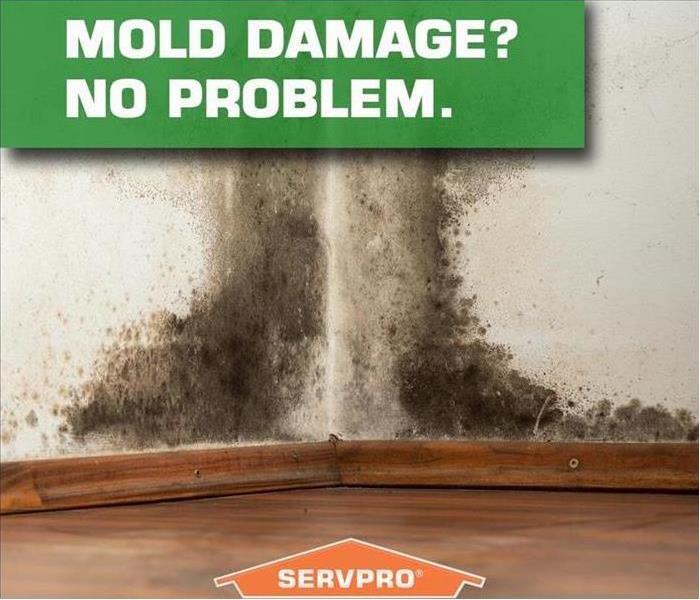 Long Island's Leader in Mold Removal and Remediation - Call us at (516) 334-2927 for a FREE Consultation
Long Island's Leader in Mold Removal and Remediation - Call us at (516) 334-2927 for a FREE Consultation
With summer, comes mold. An excessive moisture level enables household mold to grow on floors, walls, ceilings as well as in furniture, posing serious health risks on building occupants. Mold can turn out to be an uncontrollable problem in your home if not detected and eliminated on time. If there is a constant source of humidity or moisture in the space, it makes the conditions favorable enough for mold to take a complete hold on your home walls and flooring. The problem worsens if any of your family members is sensitive to allergies and/or mold specifically.
How house mold becomes uncontrollable
Mold is a natural fungus found in our environment. It is also found in buildings where dust, moisture, and dirt accumulates. While most house molds don’t bring serious problems, the little mold spores in your home can rapidly multiply in number of moist and damp environment and bring health concerns.
You must have seen mold growing on plants and food. The same way, mold grows on wood, paper, fabric and home building items such as dry wall and home furniture like carpets. All mold needs to thrive, is the moisture.
Home molds can instantly find a favorable breeding setting in homes if there is:
- High humidity level from humidifiers
- Poor venting of clothes dryer
- Too much steam-cooking
- Backed-up sewer
- Leakage in roof
- Flooding
- Constant dampness in crawl spaces and basements
- Water pooling from overflowing toilet or bathtub
- Leaking plumbing
It is to be noted that if leaks are detected on time, water is cleaned up from flooded basements, and areas are thoroughly dried out, the mold spores present in the air can be prevented to make a home in your building. Furniture or carpets that get wet, should be immediately dried in order to prevent mold growth.
How House Mold Can Cause Health Concerns
Almost all kinds of mold lead to respiratory problems. People having a sensitivity to mold get a negligible reaction, while those who are specifically allergic may have more noticeable symptoms. Certain kinds of mold are more hazardous than others since they cause severe health problems. The mold containing chemical named mycotoxin, is highly risky if inhaled.
Generally, the home mold may cause the following symptoms:
- Nasal problems such as sneezing, running nose and congestion
- Throat problems
- Wheezy, difficulty breathing
- Frequent cough
- Worsening allergy response
- Skin rashes
- Irritation in eyes
- Asthma attacks
The Vulnerable People from Mold
Though mold affects the health of everyone, yet following are the people are more vulnerable to health problems caused by home mold:
- People having asthma, allergies and/or other respiratory problems
- People having weak or affected immune system, for instance, patients having HIV
- People who are on chemotherapy medications
- People passing through or recently had organ transplant
- Elderly people since they have weaker immune system
- Toddlers, infants, and young children
How to Encounter Mold?
To control mold growth and stop the health problems caused by it, you must first strive to get rid of sources of moisture in your home. Household mold is often visible and many cases don’t require mold testing. Mold may leave a fuzzy, velvety and leathery appearance, along with shade from yellow to green to black, sometimes looks like a discoloration or stain. If you find mold or sense a musty smell, take steps to block moisture sources. The cleaning of small spaces affected by mold can be done by brushing and vacuuming or you can also hire a pro for this purpose. During brushing away mold, wear long pants and a long-sleeved shirt, rubber gloves and safety goggles.
Take prompt action and you can successfully kick the mold off your home to have a healthy mold-free living environment. For expert consultation and mold removal services, SERVPRO of East Meadow / Westbury's skilled technicians are just a call away.
Summer Means Mold Growth - where to look for mold
7/13/2017 (Permalink)
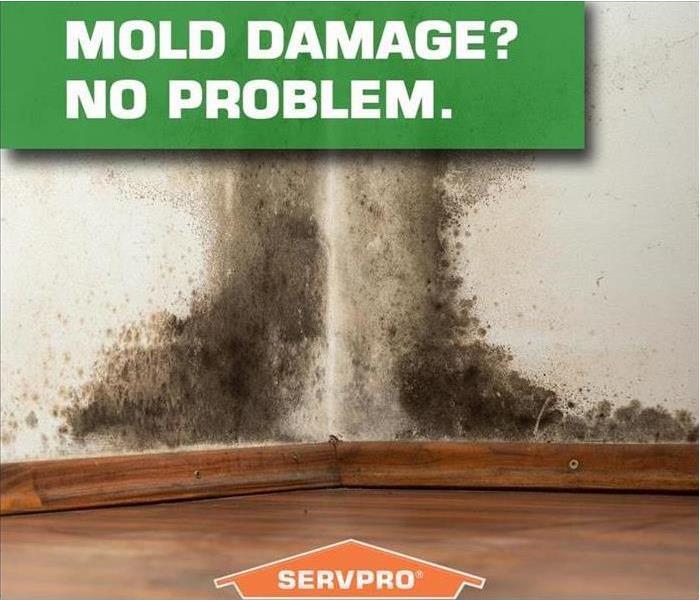 Long Island Mold Detection and Remediation Specialists.
Long Island Mold Detection and Remediation Specialists.
Summer is the season of mold growth because of the higher level of moisture and humidity in the environment. The unhygienic or dirty surroundings in home further accelerate mold growth. Mold in your homes damage floors and walls and produce unpleasant odors. In addition, it becomes the source of bringing a number of health problems for you and your family. The first thing to get rid of mold in your home is to know the most common areas where mold grows. Once you know where to look for mold in your homes in summer, you can better adopt preventive measures.
The most common mold growth areas
Though mold can be found anywhere in your home having hot and damp environment on a constant basis, yet the most common areas are:
Most of the basements are sub terrain because of their foundation function for home; however, these basements have the most favorable mold growth conditions, including long term damp environment that usually remains humid and doesn’t get satisfactory air circulation. If you are residing in the areas faced with frequent floods, the water can easily seep through small cracks in foundation or enters the basement’s doorway. The trapped moisture increases humidity after being evaporated and creates a favorable place for mold to grow.
Bathroom is the most humid areas in homes with high degree of moisture due to frequent use of water. Since moisture becomes the constant element of the environment, bathrooms may not have any chance ever to get optimum humidity level. In addition, hot baths also make your bathrooms vulnerable to mold. Bathrooms are usually devoid of adequate ventilation, lingering humidity, which becomes an ideal place for mold growth.
Inadequate ventilation leads to many issues in attics. Poor insulation installation raises low levels of moisture in home, which get trapped in attic. In addition, plumbing vents, dryer vents, kitchen and bathroom fans vented to attics continuously pump hot moist air into congested space. Installation of water furnaces or heaters in the attic is being widely seen in many large homes. If leaks are not identified and treated on time, or if the appliances are not properly installed, the risk of higher moisture level or line break increases significantly.
Crawl spaces usually have higher degree of relative humidity that is favorable to hidden mold to grow, especially if these spaces have a bare earth floor. The soil absorbs and traps moisture. The relative temperature of these spaces make the soil dry through evaporation, adding the moisture into an air in the crawl spaces, which eventually cause mold growth. Moreover, in areas having high water table and suitable weather conditions, ground water may easily penetrate into crawl spaces.
The Quick Remedies to Prevent Mold Growth in Vulnerable Areas in Homes
Here are some important tips to prevent homes from becoming an ideal place for mold growth.
- Controlling moisture level in your homes is the most important measure to stop mold growth. Any areas that are wet or damp, must be dried within 48 hours.
- Check the condensation and wet locations. Identify and repair moisture sources on immediate basis.
- Make efforts to maintain low humidity in your home; 60 percent RH maximum or below. Usually 30 to 50 percent RH is considered ideal. Try to maintain this level.
- Keep your HVAC drip pans completely clean and flowing unobstructed.
- Vent your moisture producing appliances and equipment, like dryers, to the outside.
If you are following many of these tips and still facing high mold growth, or if you are new to home repairs, you can consult Long Island's top mold remediation specialists at SERVPRO of East Meadow / Westbury for mold detection and removal.
Preventing Black Mold
12/13/2016 (Permalink)
Black mold is a problem found in many homes. It has many bad effects on humans and precautions should be taken to help reduce the risk of coming into contact with it. To prevent black Mold you should:
-Check regularly under sinks and around garbage disposals and dishwashers should be a routine task
-Check water pipes for leakage and sweating on a regular basis
-In the basement, check the faucets and fixtures of the washing machine and furnace on a routine basis
-Check the attic on regular intervals, especially during months that are humid or damp.
-Simple solar powered attic fans can be installed to help air exchange and eliminate moist conditions.
-A simple instrument can be purchased at home centers to check humidity levels in moisture laden rooms, such as the basement, bathroom, and kitchen, for around $30.
Effect Mold Has On Humans
11/9/2016 (Permalink)
Being exposed to damp and Moldy environments can cause a variety of health effects. Some people are sensitive to Molds. For these kinds of people, Molds cause nasal stuffiness, throat irritation, coughing or wheezing, eye irritation, or, in some cases, skin irritation. People with Mold allergies may have more severe reactions. People with chronic lung illnesses may get serious infections in their lungs when they are exposed to Mold. These people should stay away from areas that are likely to have Mold, This includes compost piles, cut grass, and wooded areas. Mold can enter your home through different ways. It can find its way in from open doorways, windows, vents, and heating and air conditioning systems. Mold in the air outside can also attach itself to clothing, shoes, bags, and pets can and be carried indoors.
If you think you have Mold, Call SERVPRO of East Meadow/ Westbury! We can help fix the problem and keep your health safe.
How Can You Keep Your Fall Pumpkins Free From Mold?
10/25/2016 (Permalink)
There are some simple things you can do to keep your pumpkins nice, fresh and free from Mold!
- Get some silica gel packets. These are used to wick away excess moisture. Wonder what causes your pumpkin to start rotting and molding? Excess moisture. The two are a simple but effective combination. You can find these in some recent purchases including: Beef jerky, shoes and shoe boxes, and cat litter.
- Remove silica beads from their packets. Make sure you don't leave any of these around! Even though the silica gel packets are non toxic, sometimes manufacturers add other toxic chemicals (for example, cobalt chloride) to the product.
- Embed the silica into the pumpkin. Open the top of the pumpkin, take a silica bead and embed it into the interior of the pumpkin. Use 3/4 grams of silica for every 100 cubic inches of pumpkin.
This simple trick can keep your pumpkins fresh and free from Mold for the fall season!
Mold On House Plants? Who Knew!
10/18/2016 (Permalink)
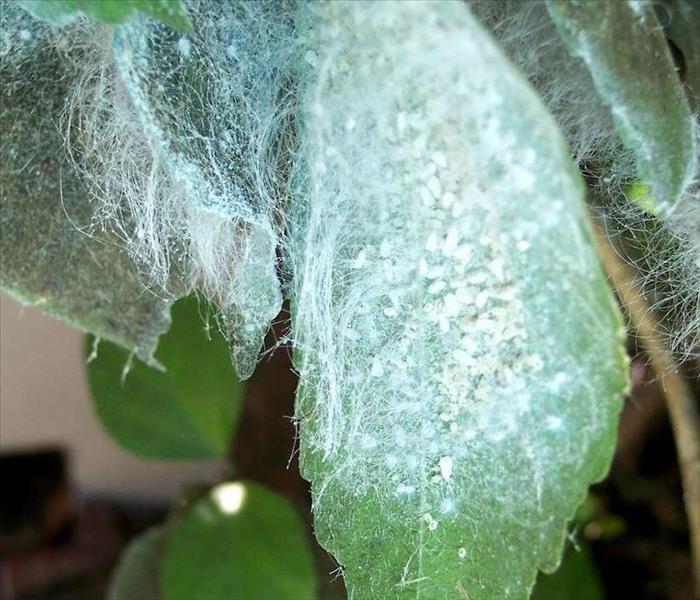 Greenhouse White Fly
Greenhouse White Fly
There are many ways to prevent the growth of Mold within your home. Small changes and adjustments to your environment can have some immediate effects on the growth or even the prevention of Mold. Mold can grow in places that you would least expect. For example, Mold growth on household plants is a rising issue in centrally heated homes. Household Mold travels in soil, on plants, and in the air. Luckily, there are ways to stop this from happening. First thing you can do is water plants deeply and infrequently. The reason for this is because shallow watering encourages growth near the soils surface, not at root level. Ohio State Univeristy recommends, keeping the humidity in your home under 85%, maintaining good air circulation, and using copper-based fungicides to control botrytis Mold.
Keep checking our blog for more unusual facts!
SERVPRO of East Meadow Westbury provides Mold damage restoration services
5/9/2016 (Permalink)
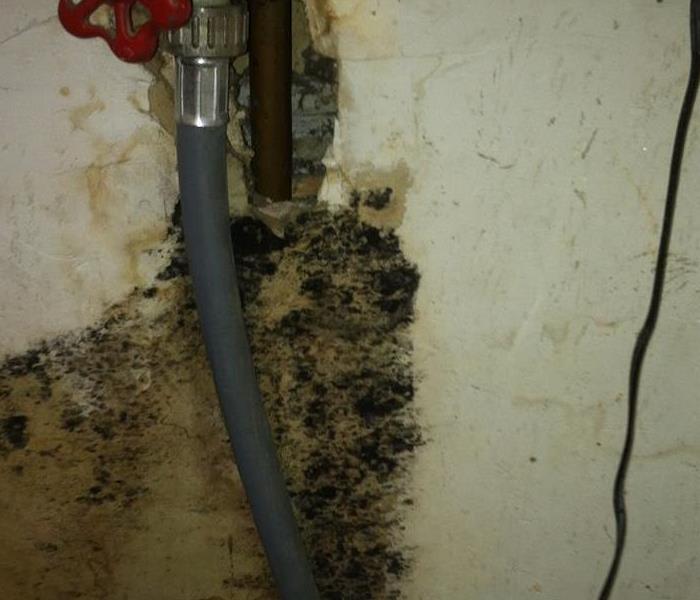 Here is a prime example of mold growth due to moisture from a water leak. As you can see, the leaky valve is directly above the mold. YIKES!
Here is a prime example of mold growth due to moisture from a water leak. As you can see, the leaky valve is directly above the mold. YIKES!
What causes Mold in Houses and what does mold needs to grow?
Mold needs these conditions before it can begin to grow in a home:
- Mold spores
- A food source (wood, Drywall, cotton)
- Darkness (mold cant grow under ultraviolet light)
- Warmth (mold cant grow in freezing temperatures)
- Oxygen
- Moisture (water, leaks, humidity)
- Enough time (most mold can begin to grow in 24-48 hours if th conditions are right)
Moisture is really the key cause of mold growth since the other conditions on the list are always going to be present in a home.
Essentially, the difference between whether or not mold grows in your home comes down to if you have a moisture problem.
How can mold develop?
12/21/2015 (Permalink)
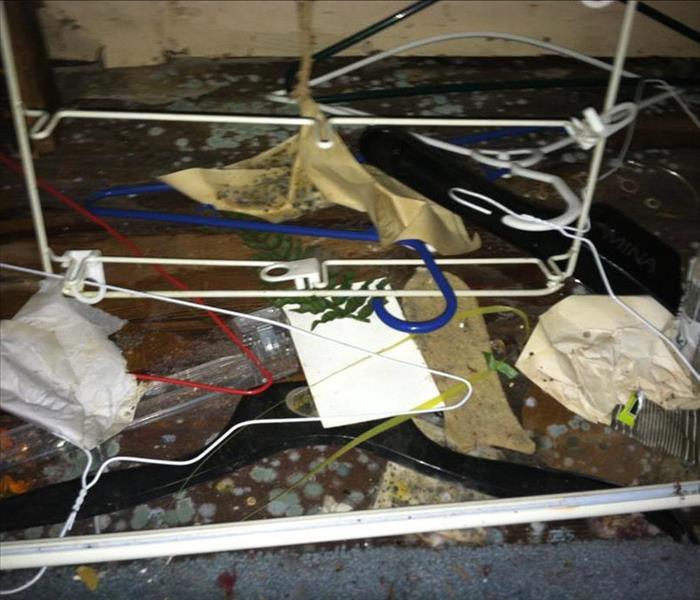 Mold on contents due to leak from pipe
Mold on contents due to leak from pipe
http://blackmold.awardspace.com/mold-causes.html




 24/7 Emergency Service
24/7 Emergency Service
